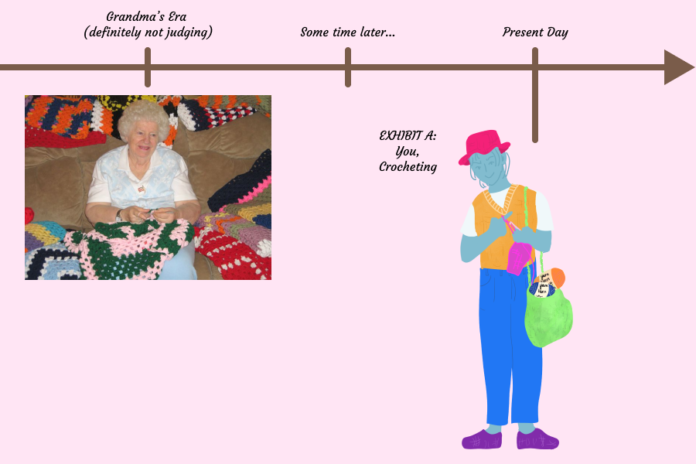How this once “domestic” activity is being reclaimed and becoming more popular
By CORALIE LOON — arts@theaggie.org
Crocheting, a textile technique that involves using a hook to turn loops of yarn into intricate cloth patterns, has been around for centuries, but thanks to social media, it has had a recent resurgence in popularity. While it is still a gendered craft, the relationship between crocheting and femininity has changed in some important ways.
According to a Martha Stewart article, Mademoiselle Riego, often referred to as the “Mother of Crochet,” published the first book on Irish crochet in 1846, which inspired a surge in crocheting in Ireland and England before its expansion to America.
With the Industrial Revolution in the mid-19th century, crocheting became a popular hobby as middle and upper-class women had more free time to twiddle their thumbs. Thus, the image of a Victorian housewife busy crocheting garments for her and her children was born.
Tasks such as quilting, sewing, crocheting or doing needlework have been traditionally tied to domestic conceptions of femininity. The portrait of a woman doing meticulous craftwork is not only prevalent in historical media but intrinsically tied to definitions of femininity that rely on concepts of service, domesticity, delicacy and beauty.
Pierre-Auguste Renoir’s 1875 painting, “Woman Crocheting,” depicts the soft and romanticized figure of a woman doing exactly what the title suggests — crocheting, but also posing for the man who is theoretically painting her, as if fulfilling his expectations of femininity.
Of course, a lot has changed between then and now. As a Reno News & Review article explains, crochet fell out of popularity with the rise of second-wave feminism, ditched as an old-fashioned, leftover piece of the patriarchy. Women were in the process of rewriting femininity, pushing for new spots in the workplace that had been denied to them for so long, and sitting home and crocheting colorful blankets just seemed to have lost its previous appeal.
Femininity, however, is still being rewritten. As the backlash to the recent M&M redesign, in which the infamous green M&M’s go-go boots were replaced with sneakers, showed us, ditching traditionally “feminine” elements in favor of traditionally “masculine” ones is a feminist tactic that is being questioned, and the mainsteamification of crochet could be an example of this.
Crochet has experienced a spike in popularity since the beginning of the COVID-19 pandemic: a few YouTube searches or scrolls through TikTok and you will inevitably find a tutorial on how to crochet all sorts of items, from bags to gloves to water bottle holders. Ironically enough, for many, the beginning of lockdown mimicked the historical experience of many middle-class European and American women: stuck at home without a traditional job and a minimal social life.
Like then, modern crochet trends are deeply intertwined with femininity. The community of crochet-creators (whether selling their products on Etsy, writing crochet patterns or posting video tutorials) is dominated by women who create mostly feminine pieces, seeing as popular crochet clothing sold on Etsy tends to be cropped, bikini-style tops, skirts and the occasional cardigan.
Despite this, the craft holds a much different relationship with femininity than it once did. Male or gender non-conforming crocheters (and customers) break the perception of who can participate in traditionally female activities, and items such as oversized sweaters, bucket hats and beanies are popular in part for their gender neutrality. Most importantly, young people today are exploring the world of crochet not because it is expected of them, but because they enjoy it and because it is a creative form of self-expression that counters the suffocation of participating in a traditional workforce.
It comes as no surprise that younger generations, increasingly well-versed in capitalism’s grip on social attitudes, may find value in art or traditionally “domestic” activities as they question why these activities have been societally undervalued.
While current crochet trends could benefit from being more gender-inclusive, the practice serves to reclaim and rewrite “femininity” as something that is useful for all genders and all people interested in expanding creative autonomy.
Written by: Coralie Loon — arts@theaggie.org




